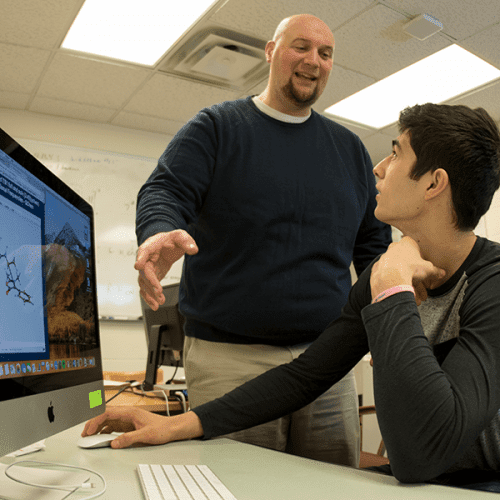Mary Unger publishes book on Black women’s role in literature during the 20th century
Posted June 5, 2025

Todd Petersen ’19 of Emerald, Wisconsin, presented research at the Midwest Undergraduate Computational Chemistry Consortium (MU3C) conference, hosted at the University of Illinois at Urbana-Champaign.
The research was conducted during the summer with Associate Professor of Chemistry Joe Scanlon in collaboration with Assistant Professor of Chemistry Patrick Willoughby. Using computational chemistry, which simulates reactions using quantum chemical calculations, Scanlon and Petersen investigated many possible reactions to create Beta-lactam molecules.
Beta-lactams are a molecule of interest because of their use in many antibiotics, and a better understanding of how they can be made can be used by other chemists in the future.
“When you observe a reaction occurring, you can propose how you think it’s occurring, but you won’t know,” Petersen says. “We modeled simulations of molecules interacting to try to figure out exactly what happens during the reaction — not just the end product, but the intermediates as well.”
Multiple potential reactions were examined computationally using MU3C’s supercomputing cluster and the WebMo and Gaussian programs. First, the molecules of interest are drawn in the WebMo program, then potential reactions are visualized using Gaussian. The project is overseen by Scanlon and has been conducted on and off over the last three years, with new students working on it over time.
The project originally was started by Caroline Kordes ’15 of Baldwin City, Kansas. Petersen, the fourth student to work on the project, was recommended to Scanlon to continue the research. Each student has been funded by the L. Leone Oyster 1919 Scholarship and Research Fund.
Originally, the project focused on synthesizing Beta-lactam molecules by combining Azlactone and Imine molecules. The proposed reaction at the time seemed unfeasible because of its high energy requirement. After re-examining the literature, the team changed the project’s focus to the reaction between Münchnone and Imines, as Azlactones were found to not be the original reactant.
For Petersen, the research was an opportunity to get better acquainted with the field of chemistry. “I learned what really goes into a research project like this, what doing chemistry research full-time is like,” Petersen says. “I hadn’t had any computational chemistry prior to this, so I learned a ton.”
This project also allowed Petersen to work personally with his professors. “It was fun being on campus and getting to really know the professors in the chemistry department,” he says.
Scanlon says this type of engagement with students makes his career all the better. “I think it’s what I enjoy most about teaching here,” he says. “Working with the students and getting deep into what is going on with the chemistry.”
Marshall Sohr ’18
Oshkosh, Wisconsin